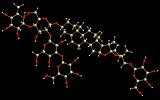It’s not something Nirvana mentioned in their elemental song, I presume they had other things on their mind, but there isn’t enough lithium in the universe. It’s not that there’s a shortage, it’s just that our knowledge of cosmic and stellar chemistry would suggest that there ought to be more of this alkali metal than there actually is. A paper published in this week’s Nature could offer an explanation.
The problem is that old stars, which ought to be made from a mixture of elements close to the ‘primordial’ blend generated in the Big Bang, don’t appear to have as much lithium as this would require. Although most of the matter produced by the Big Bang was hydrogen and helium, theories of element production predict that there should also be a fair proportion of lithium. But the amount predicted is a factor of two or three times larger than that seen in old stars. This implies that our understanding of the physics either of the Big Bang or of stars – or both – is lacking.
Andreas Korn and colleagues look at 18 stars in a cluster of old stars to see how the elemental content of their atmospheres changes with evolutionary stage. They find that various elemental abundances depend on a star’s temperature. This, the researchers say, is because heavy elements tend to diffuse deep into the star. For those stars that have evolved into giants, the elements are mixed back into the stellar atmosphere by convection, so that the stars’ composition is restored. Not so for lithium: it does not survive the trip through the stellar interior, as it is burnt when temperatures exceed 2 million degrees.
Korn and colleagues estimate that the original lithium abundance in these stars was around 78 percent higher than that suggested by current average values – which is enough to make up the discrepancy with the predicted primordial abundance.
Nature, 2006, 657-659



 Also, in partnership, Sciencebase is offering a free trial issue of Photovoltaics International to qualified subscribers – senior engineers and executives working in companies that produce wafers, cells, modules, install utility grade installations or are at current utility grade energy companies working with solar as a power generation source.
Also, in partnership, Sciencebase is offering a free trial issue of Photovoltaics International to qualified subscribers – senior engineers and executives working in companies that produce wafers, cells, modules, install utility grade installations or are at current utility grade energy companies working with solar as a power generation source.